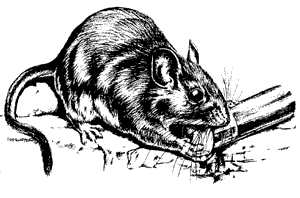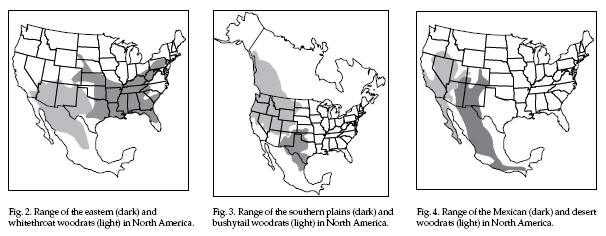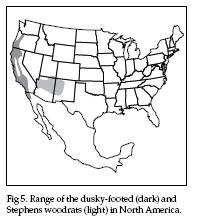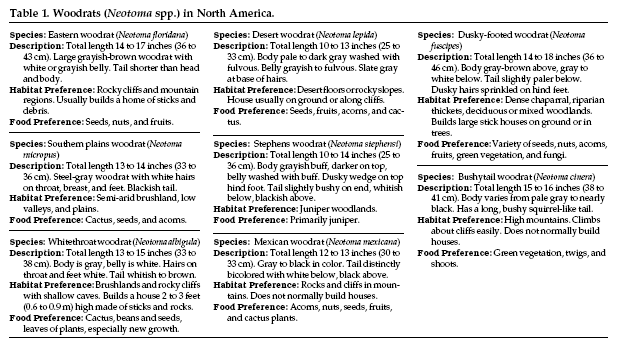|
|
|
|
 |
RODENTS: Wood Rats |
|
|

Identification
Eight species of woodrats
(genus Neotoma) occur in North America (Table 1).
Locally known as pack rats or trade rats, these rodents
are about the size of the common Norway rat. They are
distinguishable from Norway rats by their hairy rather
than scaly tail, soft, fine fur, and large ears. They
usually have light-colored feet and bellies.


Range
The ranges occupied by
woodrats are shown in figures 2, 3, 4, and 5.
Habitat
Each species of woodrat is
generally restricted to a given type of habitat within
its range. Woodrats occur from low, hot, dry deserts to
cold, rocky slopes above timberline (Table 1).
Food Habits
The food habits of
woodrats are relatively specific for the individual
species. Species such as the bushytail woodrat, for
example, feed primarily on green vegetation, twigs, and
shoots, whereas the Mexican woodrat feeds on seeds,
fruits, acorns, and cactus (Table 1). Woodrats may also
be attracted to human food supplies in buildings. When
nesting inside buildings, woodrats usually continue to
feed outside. Trails 3 to 4 inches (8 to 10 cm) wide
from the building to the outside may be visible.
Table 1. Woodrats (Neotoma
spp.) in North America.

General Biology, Reproduction, and Behavior
Woodrats climb readily and
are usually active at night. Most species build a large
stick den or house on the ground or in trees, but some
species live in rocky outcroppings. These houses are
typically occupied by one individual or by a female and
her young. One animal may inhabit several houses. A
nest, usually made of finely shredded plant material, is
located within the larger house. Breeding usually occurs
in the spring. Woodrats produce 1 to 4 young per litter
and may produce more than 1 litter per year in the
southern parts of the United States.
Damage
and Damage Identification
Populations generally are
fairly dispersed, but economic damage to agricultural
crops can occur in limited areas. Agricultural damage
results when woodrats clip small twigs and branches, and
when they debark citrus and other fruit trees and
seedling and sapling conifers, especially redwoods. Loss
of trees can occur.
Woodrats are sometimes a
nuisance around cabins, outbuildings, and other
infrequently used structures or vehicles. As the name
“packrat” implies, they have a tendency to pack away
small objects such as jewelry, cooking and eating
utensils, can tabs, and other items. At times, this
behavior can become a nuisance to backpackers and
others. More seriously, woodrats may also shred
upholstered furniture and mattresses for lining nests,
and may take up residence in parked vehicles, gnawing on
wires and other mechanical components.
Woodrats can be an
important factor in the transmission of certain
diseases, most notably plague, where this disease
occurs. Dead or dying woodrats should not be handled.
Legal Status
Woodrats are classified as
nongame animals. In most states they can be taken
(controlled) when they threaten or damage property.
Check with your local wildlife or agriculture department
for laws and regulations specific to your area. For
example, the Key Largo woodrat (Neotoma floridana smalli)
was federally listed as endangered in 1991.
Damage
Prevention and Control Methods
Exclusion
When nuisance problems
occur in and around buildings, exclusion is the most
effective method of eliminating damage. Woodrats may be
excluded from buildings by the same methods used to
exclude Norway and roof rats. Since several species of
woodrats are agile climbers, all entrances to buildings,
including those at the attic level, must be closed.
Cracks and openings in building foundations, and any
openings for water pipes, electric wires, sewer pipes,
drain spouts, and vents must be sealed. Also check for
openings in attic vents, broken roof shingles, or other
gaps next to the eaves. No hole larger than 1/2 inch
(1.3 cm) should be left unsealed. Make sure doors,
windows, and screens fit tightly. If gnawing is a
problem, edges can be covered with sheet metal. Coarse
steel wool, wire screen, and lightweight sheet metal are
excellent materials for plugging gaps and holes. Plastic
sheeting, wood, or other less sturdy materials will
likely be gnawed away. When rodent-proof-ing, be sure
the woodrat is not trapped inside the building. One way
to accomplish this is to install a temporary gravity
door made of sheet metal or rigid mesh wire, hinged at
the top, over entrance holes. The woodrats can push it
open to exit but cannot reenter.
Repellents
Objectionable odors from
substances like mothballs (naphthalene), or tacky
substances, may make an enclosed area temporarily less
desirable for woodrats, as for other mammals. Likewise,
noxious tastes may make an item less palatable. No
woodrat repellents, however, are registered by the EPA.
In general, chemical repellents are not considered a
practical solution to woodrat problems.
Toxicants
Toxicants available for
woodrat control include anticoagulants and zinc
phosphide, registered under Special Local Needs 24(c)
provisions. Registered products vary among states. When
using toxic baits, follow label instructions carefully.
Anticoagulants are
effective for woodrat control and are especially suited
for use around structures because of their low hazard to
pets and children. Most baits formulated for commensal
rats and house mice give effective woodrat control.
Anticoagulants work by interfering with the
blood-clotting mechanism. Death usually occurs 4 to 5
days after feeding on bait begins. With most
anticoagulants, such as chlorophacinone or diphacinone,
feeding must occur daily for 4 to 5 days. Finely ground
or meal-type anticoagulant baits are recommended. Since
woodrats have a tendency to pack away items, pellet bait
should be avoided since it is often cached at the nest
site. Cached bait is probably not effective in
minimizing reinvasions of the area, so it is essentially
wasted and may present hazards to nontarget species.
Anticoagulants are usually
put out in bait boxes, but woodrats tend to fill boxes
with sticks and other debris. Therefore, use open bait
containers. Bait exposed in this manner must be placed
so nontarget species, pets, and children do not have
ready access to it. Access to the bait by pets can be
minimized by inverting a wooden crate over the bait
tray. Baiting sites should be located near existing
woodrat runways, feeding sites, or nests.
Anticoagulant paraffin
bait blocks have also proven valuable for woodrat
control. Because of the paraffin, the bait has more
resistance to molding caused by moisture and, therefore,
lasts longer. These bait blocks are particularly useful
in mountain cabins or other structures where woodrats
gain access when the building is unoccupied. The bait
block should be nailed or tied down to prevent the
woodrat from packing it away. When the label permits,
bait blocks may also be wired to tree limbs or other
elevated locations.
In agricultural
situations, zinc phosphide is a Restricted Use Pesticide
and must be applied by a certified applicator.
Steam-rolled oats or oat groats treated with 2.0% zinc
phosphide are generally very effective on woodrats.
Usually, tablespoon (4 g) amounts are scattered in
runways near the nest site. Zinc phosphide bait should
be applied in late afternoon just prior to woodrats’
night-time feeding. Feeding on a sub-lethal amount of
zinc phosphide bait can result in bait shyness.
Therefore, do not use zinc phosphide more than once per
6-month period.
In some cases, the use of
second generation anticoagulants (for example,
brodifacoum, bromadiolone) or other toxicants (cholecalciferol)
may be permitted for woodrat control. Based on Section 2
of FIFRA (Federal Insecticide, Fungicide, and
Rodenticide Act), EPA ruled that it is legal, unless
otherwise specifically prohibited, to use a pesticide
against a target species not listed on the label if the
label directions for a listed pest are followed. The
site to be treated must be mentioned on the label and
there must be reason to believe the application will be
effective. For example, the use of cholecalciferol to
control woodrats in or around buildings could be
permissible because the label lists Norway or roof rats
and specifies in or around buildings. Not all states
accept the EPA ruling. Check with the appropriate
pesticide enforcement agency prior to pursuing this
course of action.
Trapping
The majority of woodrat
problems in structures can be dealt with by using one or
several traps. Woodrats show little fear of new objects
in their environment and are easily trapped. The
standard rat snap trap is quite effective for woodrats.
Trap bait should be wedged into or tied to the treadle.
Good baits include nut meats, bacon rind, peanut butter
and oatmeal, prunes, raisins and other dried fruit, and
biscuits.
Live catch traps, using
the same baits as above, can be used for woodrats.
Release of trapped animals is not recommended and may be
against local fish and game regulations. Also, many
studies have shown that animals released into new areas
often die from exposure, predation, or competition with
resident animals.
Burrow-entrance traps such
as the No. 110 Conibear® trap may also be useful for
woodrat control. The trap is placed in nest openings or
other restricted travelways and is triggered when the
woodrat passes through the trap opening. When traps are
set in this manner, baiting is not necessary, but care
must be taken to avoid nontarget animals.
Glue boards are also
effective for trapping woodrats. These work on the same
principle as flypaper; when a rat attempts to cross a
glue board, it gets stuck. Glue boards tend to lose
their effectiveness in dusty areas, and temperature
extremes may affect the tackiness of the adhesive. In
many cases, woodrats trapped on glue boards will not die
immediately. If they don’t, they can be euthanized by
placing the board in a plastic bag and adding carbon
dioxide gas.
Remember, all traps and
glue boards should be placed so that children, pets, and
other nontarget animals do not have access to them.
Other Methods
Destroying woodrat nests
has been suggested as a method of control. When a nest
is destroyed, the animals may run for cover, thus
exposing them to predation by humans or dogs. This
method of control is time-consuming and probably of
limited value. Once the woodrats in an area are
controlled, however, destroying their nests may reduce
invasion by other woodrats.
Economics of Damage and Control
Nationally, woodrats are a
minor pest. They only occasionally become numerous
enough to cause significant agricultural damage. In most
cases, woodrats are a nuisance around vacation homes,
cabins, and other outbuildings. Their stick nests can be
extensive and their physical presence and droppings are
often objectionable. Woodrats can carry diseases and
ectoparasites. Therefore, close association with humans
is undesirable. In most nuisance situations, control can
be accomplished by the resident or homeowner.
Acknowledgments
Figure 1 from Schwartz and
Schwartz (1981).
Figures 2, 3, 4, and 5
adapted from Burt and Grossenheider (1976) by David
Thornhill.
For Additional Information
Burt, W. H., and R. P. Grossenheider. 1976. A field
guide to the mammals, 3d ed. Houghton Mifflin Co.,
Boston. 289 pp.
Linsdale, J. M., and L. P.
Tevis. 1951. The dusky-footed wood rat. Records made on
Hastings Natural History Reservation. Berkeley,
California. 675 pp.
Schwartz, C. W., and E. R.
Schwartz. 1981. The wild mammals of Missouri, rev. ed.
Univ. Missouri Press, Columbia. 356 pp.
Vorhies, C. T., and W. P.
Taylor. 1940. Life history and ecology of the
white-throated wood rat, Neotoma albigula Hartly, in
relation to grazing in Arizona. Univ. Arizona Tech.
Bull. 49:467-587.
Wiley, R. W. 1980. Neotoma
floridana. Mammal. Species. 139:1-7.
Editors
Scott E. Hygnstrom Robert
M. Timm Gary E. Larson
PREVENTION AND CONTROL OF
WILDLIFE DAMAGE — 1994
Cooperative Extension
Division Institute of Agriculture and Natural Resources
University of Nebraska -Lincoln
United States Department
of Agriculture Animal and Plant Health Inspection
Service Animal Damage Control
Great Plains Agricultural
Council Wildlife Committee
Special
thanks to:
Clemson University
|